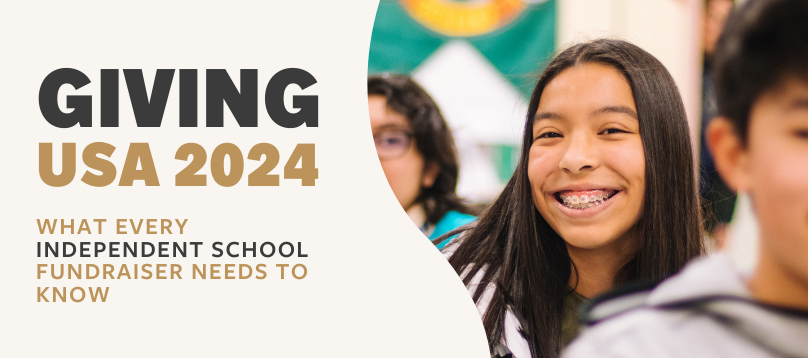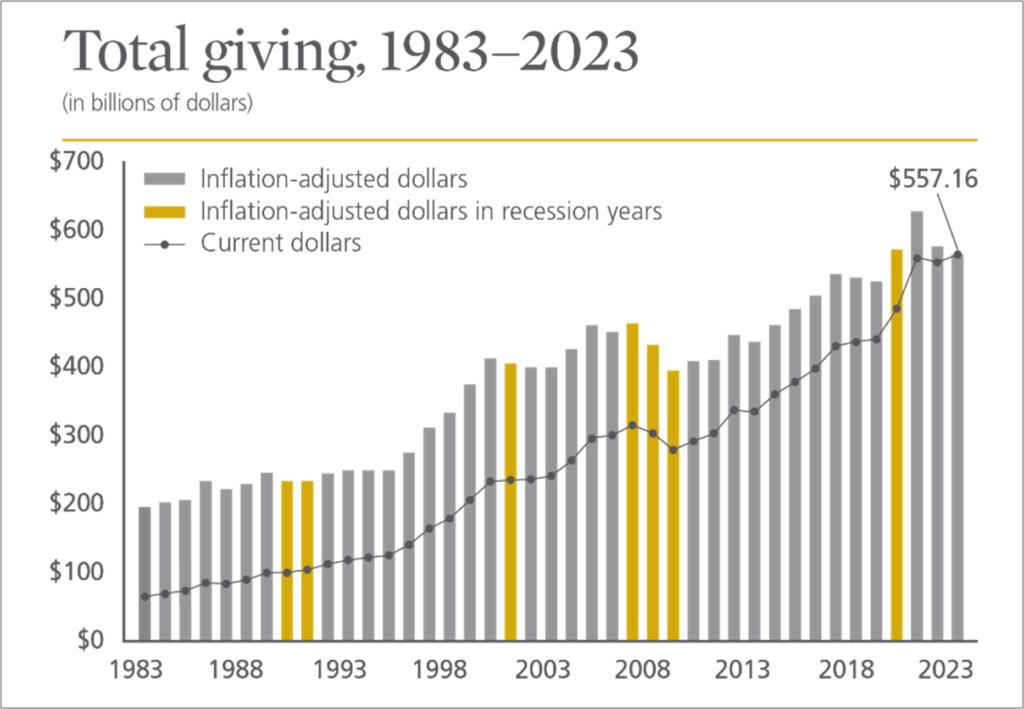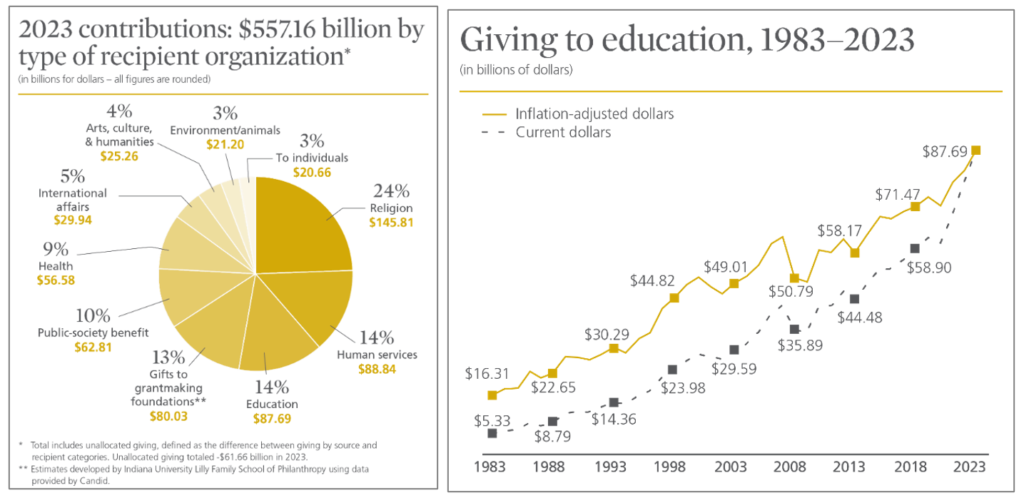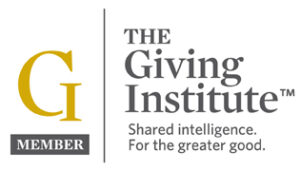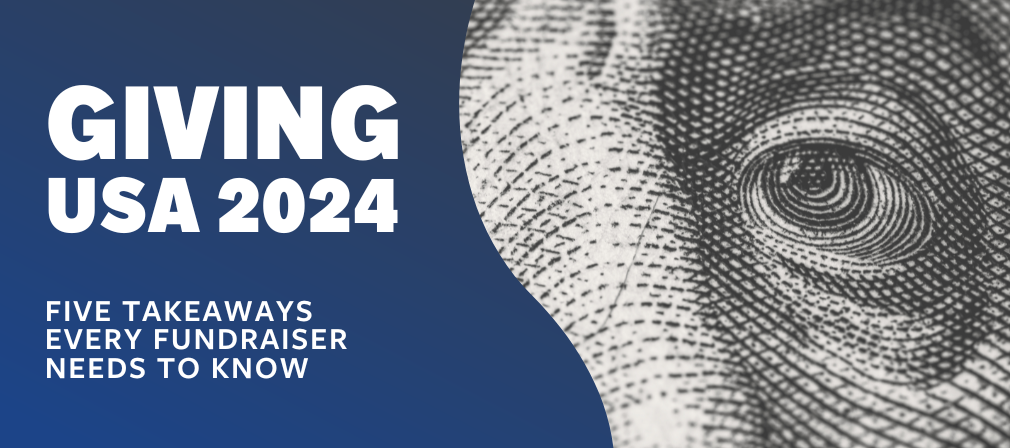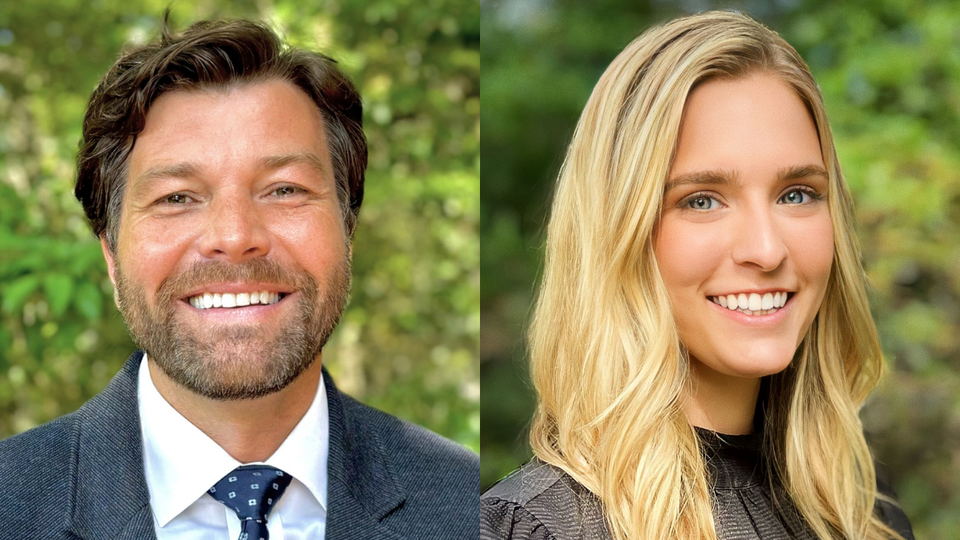Fair warning—the news isn’t great.
Because statistics without context are irrelevant, we have compiled five Giving USA 2024 takeaways that pass the “So What?” test. They’re written with the front-line fundraiser in mind and designed to help you:
- Develop 2025 fundraising strategies
- Brief your colleagues and board members
- Build donor journeys that are in line with current trends in giving
- Stimulate philanthropy and reverse the Generosity Crisis
Takeaway #1: Don't Look at the Headlines and Think Everything is Great
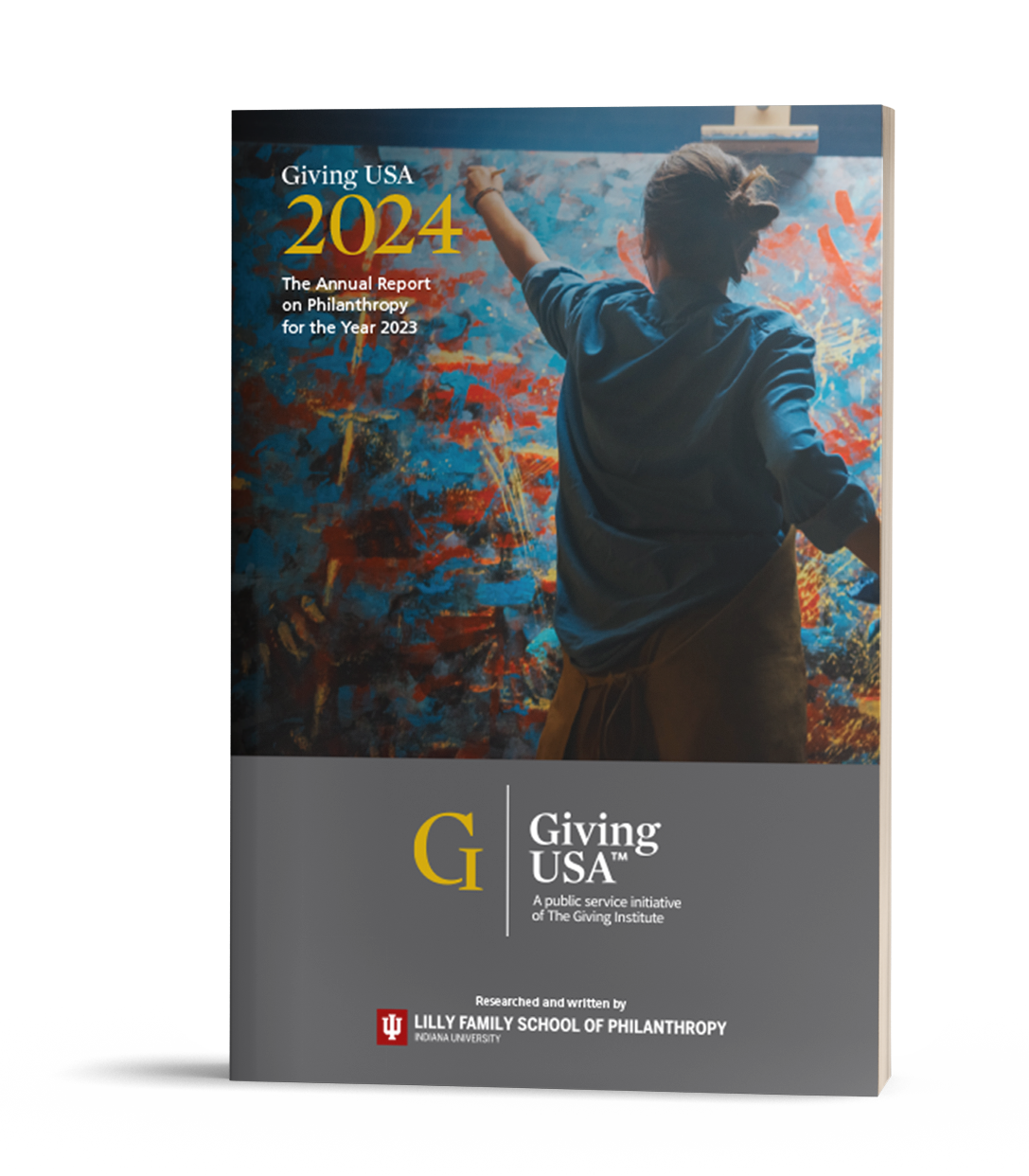
In 2023, donors had the capacity to give…and give big. Instead of the recession many economists warned us about, the economy soared last year. On paper, it was one of the most robust ever.
So why did giving drop 2.1 percent?
This year’s Giving USA headline—that Americans gave a record $557 billion in philanthropic gifts—isn’t something to celebrate.
Instead, look deeper and see what we’re seeing: philanthropy is trending in the wrong direction.
Too many indicators are off.
In 2023, the number of donors dropped 3.4 percent.
The number of donors dropped in every category, from the everyday to the mega donor.
Donor retention rates declined across all donor types.
Individual giving as a share of disposable income was only 1.9 percent—close to the all-time low of 1.7 percent.
Takeaway #2: Last Year Was Full of Wasted Philanthropic Potential
The 2023 stock market hit record highs: the S&P 500—the stock market performance index—grew 24.2 percent (19.3 percent adjusted for inflation).
Disposable personal income grew 4.2 percent. Corporate profits increased 1.5 percent on top of 2022’s 9.8 percent increase. It would make sense that giving—historically correlated with stock market performance—would follow suit. And in current dollars, it did. Giving last year was the highest on record at $557.16 billion.
But giving didn’t even outpace inflation. Some will make the case that inflation itself was the problem, and perhaps it was behind some of the declines. The economy was simply too robust to make it the sole scapegoat.
The GDP grew by 6.5 percent in 2023 yet giving as a percentage of GDP fell from a high of 2.3 percent in 2021 to only 2.0 percent. Corporate giving declined by 1.1 percent when adjusted for inflation.
Yes, we can still make the case that America is an incredibly generous country: $557 billion in gifts is remarkable.
But what could the total have been?
What if we—the inspirers of philanthropy—had spent more time building authentic relationships with our donors and making the case for their gifts?
Simply put, in 2023 we didn’t do enough to convince donors to shift their spending away from consumer goods and services and towards philanthropic giving.
Too many development and advancement shops are focused on the wrong things. Galas, silent auctions, and golf tournaments may raise funds, but they consume too much staff and volunteer time while doing little to build real relationships with donors. Donor acquisition campaigns are important, but too often they are prioritized over cultivation and stewardship. Instead, focus on building intentional relationships with your donors. To lighten the load and make the process more meaningful to families, develop strategies that involve your advancement committee, your head of school, and other department heads.
When building cultivation strategies, make sure your focus is in the right place. We see too many schools that identify and qualify donors by zip code or neighborhood, instead of by getting to know their families.
New tools can help with more effective donor qualification. Predictive AI can help identify the most philanthropic alumni and current families—and even indicate giving patterns. Using this information to develop customized cultivation strategies will yield far better results by helping you prioritize your time.
Takeaway #3: Giving to Education Was a Bright Spot
If there is a positive in this year’s Giving USA, it is giving to education.
In 2022, giving to education as a sector dropped to third place (behind the percentage of gifts to religion and human services). This past year, giving to education was robust—growing by 11.1 percent (6.7 percent when adjusted for inflation). This growth was enough for education to reclaim its second-place spot (tied with human services).
During academic year 2023-2024, median funds received by independent schools increased by 5.9 percent to $1.51 million; the median number of donors increased by 2.5 percent to 570 donors. Median funds received for all purposes including operations, endowment, and capital also grew over the prior academic year.
Although median giving per independent school student fell to $3,705 during academic year 2023–2024, it remained nearly double the amount given during academic year 2021–2022 ($1,867).
Giving to education grew 11.1 percent in 2023, making it one of the bright spots of this year’s Giving USA report.
Economists are painting a rosy picture for the coming year and one that is favorable for large, transformative gifts. If your school is considering a campaign, now is an ideal time to start planning. This resource can help you get started.
Takeaway #4: Are We Seeing the End of Mega Gifts?
It’s impossible to ignore the impact of gifts at the highest levels.
The Fundraising Effectiveness Project found that over half of all fundraising dollars in 2023 came from donors who gave $50,000 or more. Donors who gave $5,000 or more accounted for 76 percent of all donated dollars, yet less than 3 percent of all donors.
Despite the totals, the FEP found a 7.4 percent decline in the number of donors giving $50,000 and above. This decline was the largest of any donor category ranked by size of gifts.
This decline in mega gifts may continue in 2024. The Chronicle of Philanthropy reported that wealthy donors gave almost $300 million more between January and May 2024 than they did over the same period in 2023. However, a $1 billion gift made by Ruth Gottesman to the Albert Einstein College of Medicine skewed the data. When that gift was removed, giving from the wealthiest donors actually declined by 14 percent.
Fundraising consulting firms like the
Winkler Group can analyze your database and use predictive AI to determine
which of your current, lapsed, and unclassified donors are the best major gift
suspects. This information enables you to prioritize where to spend your time.
Because predictive AI includes data about a
donor’s giving priorities, this data will also help you better qualify donors
and develop customized cultivation and solicitation strategies.
To see how it can be used with your
database, schedule a consultation with one of our experienced fundraisers.
Mega gifts receive an outsized amount of attention, particularly as most nonprofits will never receive one. Unfortunately, these gifts receive the lion’s share of media attention, prompting many nonprofit leaders and board members to chase them—or question why their development staff hasn’t received one.
Chasing large mega gifts, particularly from a source with no connection to the organization, is fruitless. Look instead at your own database and find potential there. Donors have the capacity to give transformational amounts across all nonprofit sectors, but those gifts are going to the organizations and institutions that build authentic relationships with their donors. Be intentional about understanding the problems your donors want to solve; treat them like investors and show them the impact they are making in helping you solve those challenges.
Takeaway #5: Foundation Giving Continues to Rise
Giving by foundations surpassed $100 billion for the second year in a row, representing 19 percent of total giving. Forty years ago, foundations only represented 6 percent of total giving.
The rise in giving by foundations can be attributed to two factors.
First, more wealthy donors are choosing to make their gifts through intermediaries like family foundations and DAFs. Of the five mega gifts Giving USA lists in this year’s report (classified as $550 million or more), four went to foundations and not directly to a recipient.
Second, foundations increased their cumulative grantmaking beginning in 2020 to address issues such as the pandemic and social movements for racial justice. Candid’s Foundation Giving Forecast Survey found the increase in cumulative grant dollars continued in 2023.
Please do not misinterpret the rise in foundation giving as a shift away from individual giving. This does not mean that development and advancement shops should replace front-line fundraisers with grant writers. As wealthy donors continue to shift their giving vehicles to family foundations and DAFs, the traditional cultivation of individual donors should remain a priority. Regardless of whether the gift comes through their foundation or directly from the donor, relationships the organization has built over the years will still prompt the gift.
The Opportunity...What Will You Do with It?
Economists from Bank of America predict that the S&P 500 could rise another 19 percent by August 2025.
This is important because giving is highly correlated with stock market performance. And because wealthy donors have long prioritized giving to education over all other sectors, this prediction should be welcome news for academic fundraisers.
The Philanthropic Outlook, published in March of this year by Indiana University Lilly Family School of Philanthropy and CCS, predicts total giving will increase by 4.2 percent in 2024 and by 3.9 percent in 2025. It attributes the increase to a growing stock market and growth in consumer sentiment.
Because these economic predictions suggest continued growth, we predict continued investment from donors.
However, donor giving is never a given.
Those schools that intentionally work to engage families and alumni and demonstrate the impact of investment beyond tuition will be the ones that reap the rewards. And when done properly, this type of donor engagement is long-term, providing the resources that can catapult a school’s learning environment and the student experience to the next level.
About the Report
Giving USA: The Annual Report on Philanthropy, the longest-running and most comprehensive report on the sources and uses of charitable giving in America, is published by Giving USA Foundation, a public service initiative of The Giving Institute. It is researched and written by the Indiana University Lilly Family School of Philanthropy at IUPUI.
References
Association of Fundraising Professionals & GivingTuesday. (2024). Quarterly fundraising report: Year-to-date nonprofit sector trends: Q4 2023 (JAN 1, 2023 – DEC 31, 2023). In Fundraising Effectiveness Project. https://afpglobal.org/fundraising-effectiveness-project-reports-library
Bureau of Economic Analysis. (2024, May 30). Corporate profits. https://www.bea.gov/data/income-saving/corporate-profits
Di Mento, M. (2024, June 17). Big gifts rise 6% this year, aided by a single giant donation. https://www.philanthropy.com/article/big-gifts-rise-6-this-year-aided-by-a-single-giant-donation
Flannery, H., Collins, C., & Devaan, B. (2023, December 5). REPORT: The true cost of billionaire philanthropy. Institute for Policy Studies. https://ips-dc.org/report-true-cost-of-billionaire-philanthropy/
Fox, M. (2024, April 16). The stock market just flashed bullish a signal suggesting 19% upside by August 2025, BofA says. Markets Insider. https://markets.businessinsider.com/news/stocks/stock-market-prediction-bull-signal-suggests-big-gain-august-2025-2024-4
Giving USA Foundation. (2024). Giving USA: The Annual Report on Philanthropy for the Year 2023.
National Association of Independent Schools. (n.d.). NAIS – Facts at a glance. https://www.nais.org/analyze/statistical-tables/facts-at-a-glance/
Sato, G. (2024, June 12). Foundation giving remained steady in 2023. What’s the outlook for 2024? Candid Insights. https://blog.candid.org/post/foundation-giving-data-in-2023-expected-grantmaking-in-2024
School of Philanthropy, Indiana University Lilly Family. (2024, March 1). The Philanthropy Outlook 2024-2025 Report. https://scholarworks.indianapolis.iu.edu/items/499ae1f5-c885-4aa3-aa49-1f27534dd096

